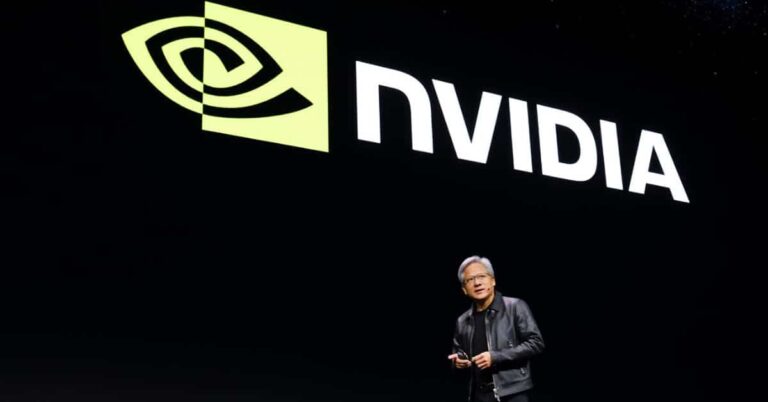Nio's models currently come standard with four Nvidia Orin chips, but it will carry its own in-house developed chip in the ET9, which it will start delivering next year.
(Image credit: CnEVPost)
Nvidia's (NASDAQ: NVDA) next-generation Drive Thor chip is adopted by more Chinese electric vehicle (EV) makers, as smart driving is seen as key to the next stage of competition in the EV industry.
The US chip giant announced overnight that leading companies in the transportation sector have adopted Drive Thor centralized car computer to power their next-generation consumer and commercial fleets.
These companies, which include BYD (HKG: 1211, OTCMKTS: BYDDY), Xpeng (NYSE: XPEV), and GAC Aion's premium brand Hyper, join Li Auto (NASDAQ: LI) and Zeekr, which have already announced that they are building their future vehicle roadmap on Drive Thor, according to Nvidia's statement.
Nvidia announced Drive Thor, a new system for autonomous driving, on September 20, 2022, as a successor to Drive Orin, targeting automakers' 2025 models.
The system-on-a-chip (SoC) builds on the latest CPU and GPU advances to deliver 2,000 teraflops (Tops) of performance, and manufacturers can use them all for the autonomous driving pipeline, or some for in-vehicle AI and infotainment systems, and some for driver assistance.
Nvidia's most advanced such SoC at the moment is the Drive Orin, which is being used by many Chinese EV makers, including Nio (NYSE: NIO), and can deliver 254 Tops of computing power each.
In 2021, Nvidia unveiled Altan, an autonomous driving chip to replace Orin, capable of delivering 1,000 Tops of performance and had been scheduled to be available in 2024.
However, Altan was replaced before it became available by the more powerful Thor, which had eight times the power of Orin and twice the power of Altan.
When Nvidia unveiled Thor in September 2022, it announced that Geely Holding's Zeekr would be the first EV maker to use Thor, with production of Zeekr models powered by the SoC set to begin in early 2025.
On January 8, Nvidia said that Li Auto has selected Thor to drive its next-generation fleet.
It's interesting to note that Nio, one of Drive Orin's major customers, did not select the Thor SoC.
Nio's current eight models come standard with four Orin chips to power its assisted driving system.
Nio unveiled its first in-house developed autonomous driving chip at Nio Day 2023 on December 23, 2023, which will be used in the ET9 executive flagship sedan that will begin deliveries in the first quarter of 2025.
The chip, called the Shenji NX9031, is built on a 5 nm process and has comparable computing power to four Nvidia Drive Orin X chips, Nio founder, chairman, and CEO William Li said at the time.
Drive Thor is an in-vehicle computing platform designed for generative AI applications that are becoming critical in the automotive industry, Nvidia said in its statement overnight.
The system is the successor to Drive Orin and delivers feature-rich cockpit functionality, as well as safe and reliable highly automated and autonomous driving, all on a centralized platform, Nvidia said.
This next-generation autonomous vehicle platform will integrate the new Nvidia Blackwell architecture, designed for transformer, LLM and generative AI workloads, which was announced during Nvidia founder and CEO Jensen Huang’s keynote at GTC.
"Drive Orin continues to be the AI car computer of choice for today’s intelligent fleets, but now we’re seeing mobility leaders looking ahead to bring Nvidia Drive Thor into their next-generation, AI-enabled vehicle roadmaps," said Wu Xinzhou, vice president of automotive at Nvidia.
Wu was previously head of Xpeng's autonomous driving business and joined Nvidia in August 2023.
BYD is expanding the scope of its ongoing partnership with Nvidia beyond the car to the cloud.
In addition to building its next-generation EV fleet on Drive Thor, BYD plans to use Nvidia's AI infrastructure for cloud-based AI development and training technologies, as well as the Nvidia Isaac and Nvidia Omniverse platforms to develop tools for virtual factories and application planners and retail configurators, according to Nvidia.
Hyper has selected Drive Thor for its next-generation EV, which will go into production in 2025 with level 4 driving capability, Nvidia said.
Hyper is currently using Nvidia Drive Orin to power its flagship Hyper GT model, which features level 2+ driving capabilities.
Xpeng also announced that it will use the Nvidia Drive Thor platform as the AI brain for its next-generation EV fleets, Nvidia said.
The next-generation car computer will power Xpeng's proprietary XNGP AI-assisted driving system, enabling autonomous driving and parking functions, driver and passenger monitoring, and other features, according to Nvidia.


